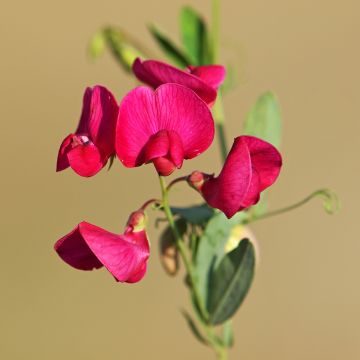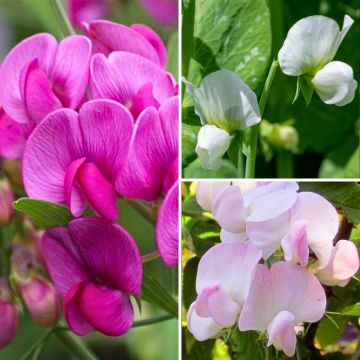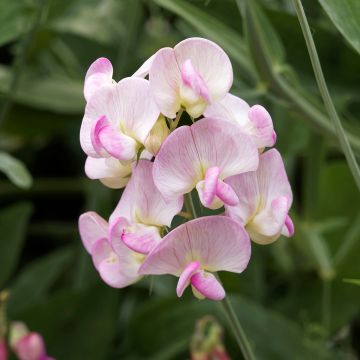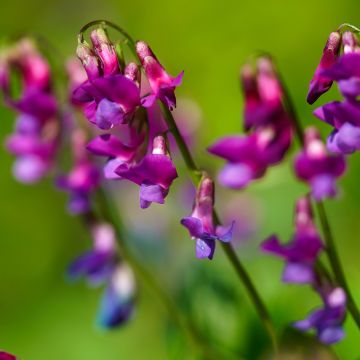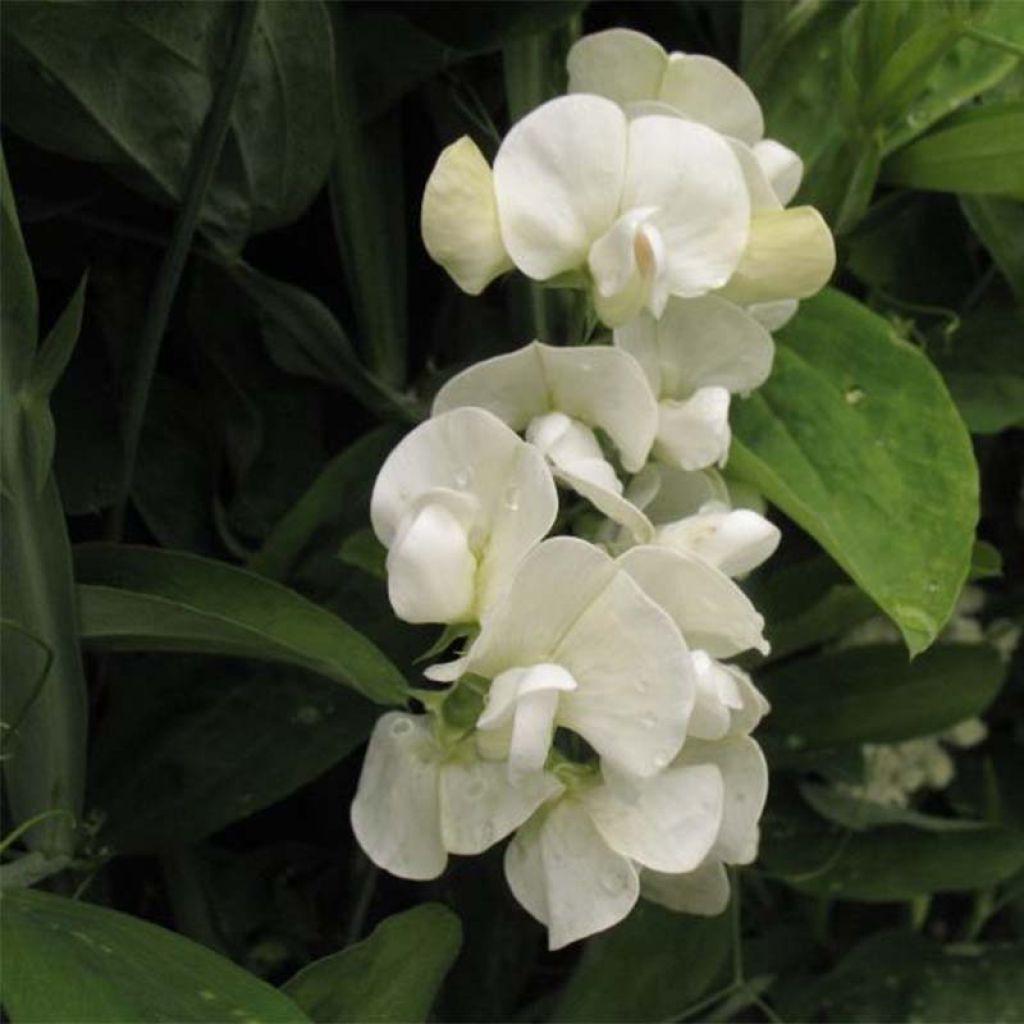

Lathyrus latifolius White Pearl - Broadleaf Sweetpea
Lathyrus latifolius White Pearl - Broadleaf Sweetpea
Lathyrus latifolius White Pearl
Broadleaf Sweetpea, Broad-leaved everlasting-pea, Perennial Pea
This item cannot be shipped to the selected country
Delivery charge from €5.90
Delivery charge from €5.90
More information
Schedule delivery date,
and select date in basket
This plant carries a 12 months recovery warranty
More information
We guarantee the quality of our plants for a full growing cycle, and will replace at our expense any plant that fails to recover under normal climatic and planting conditions.
From €5.90 for pickup delivery and €6.90 for home delivery
Express home delivery from €8.90.
From €5.90 for pickup delivery and €6.90 for home delivery
Express home delivery from €8.90.

Does this plant fit my garden?
Set up your Plantfit profile →
Description
Lathyrus latifolius 'White Pearl', also known as the Everlasting Sweet Pea 'White Pearl', is an adorable small climbing plant, which flowers throughout the summer with clusters of papilionaceous flowers in a pure white shade. These flowers are quite large but without fragrance. The plant creeps on the ground or clings to its support thanks to a few tendrils that suspend its bluish-green foliage and its broad flattened stems. Light and devilishly romantic, this Everlasting Sweet Pea is also a very hardy and drought-resistant plant, which loves the sun and a rather fertile well-drained soil.
Introduced before 1635, the perennial pea became popular in the 1900s; it was often cultivated on a floral cage, a very fashionable accessory in Victorian England. This Everlasting Sweet Pea is a plant of the Fabaceae family native to Chile, which has become naturalised in Europe, in southern regions, where it grows in sunny fallow land on rather chalky soil. With rapid growth, the stems develop tendrils that cling to the support you have carefully provided during planting. Growing from a large fleshy root, this plant easily reaches 1.80 m (6ft) in a few months. Flowering takes place from June-July to September if it does not lack water. Its papilionaceous flowers, 2 to 3 cm (1in) long, are grouped in axillary clusters of 10 to 15 flowers. It is an excellent cutflower. If it is happy, the Everlasting Sweet Pea is so vigorous that it can become invasive by abundantly self-seeding.
This charming plant has more than one feature: captivating bluish foliage, small clusters of tightly curled buds, and finally the vivacity of its carmine pink flowers. It thrives in warm and sunny places as well as in well-drained or even rocky soils. It is a perfect plant for quickly dressing up a brand new garden, a slightly wild area, the somewhat sad branches of conifers or deflowered spring-flowering bushes, including roses. Easy to grow, the large seeds of Lathyrus latifolius are easy to handle and can be easily sown by children. This Everlasting Sweet Pea is perfect for flowering a trellis, a fence, and even a pot on the patio throughout the summer, mixing pink, red, and white varieties. This pea is an aerial climber with a formidable foot. If it settles in the garden, it multiplies and spreads at will, climbing over other perennials without smothering them under its light weight. In a bouquet, it remains beautiful for several days, with the buds opening in white tinged with green, they are very refined and mix well with a few spikes of fragrant Buddleia.
Report an error about the product description
Lathyrus latifolius White Pearl - Broadleaf Sweetpea in pictures
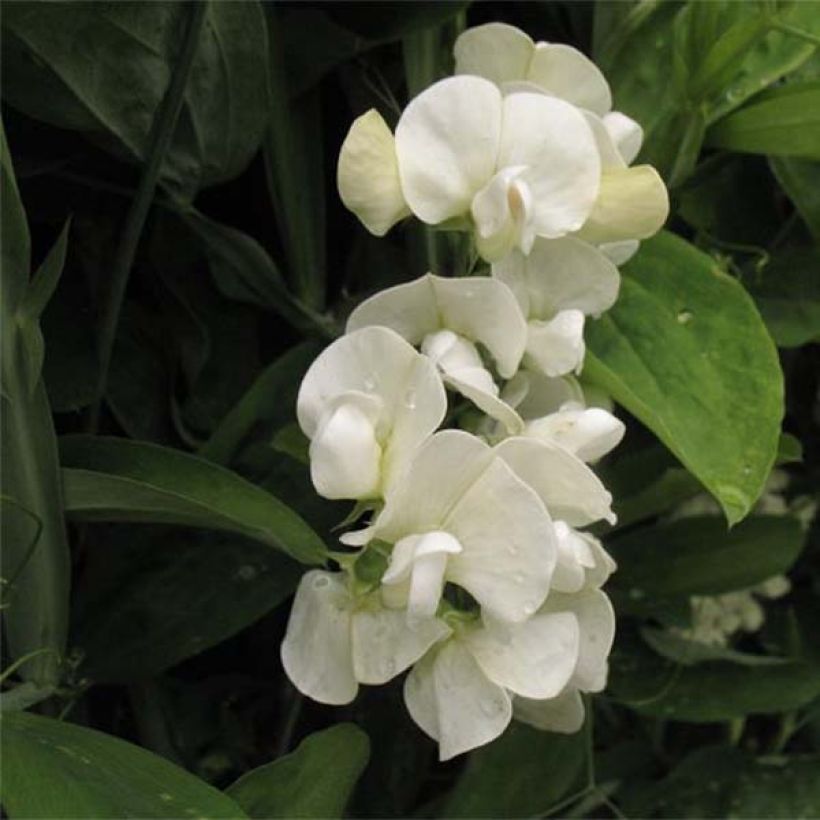

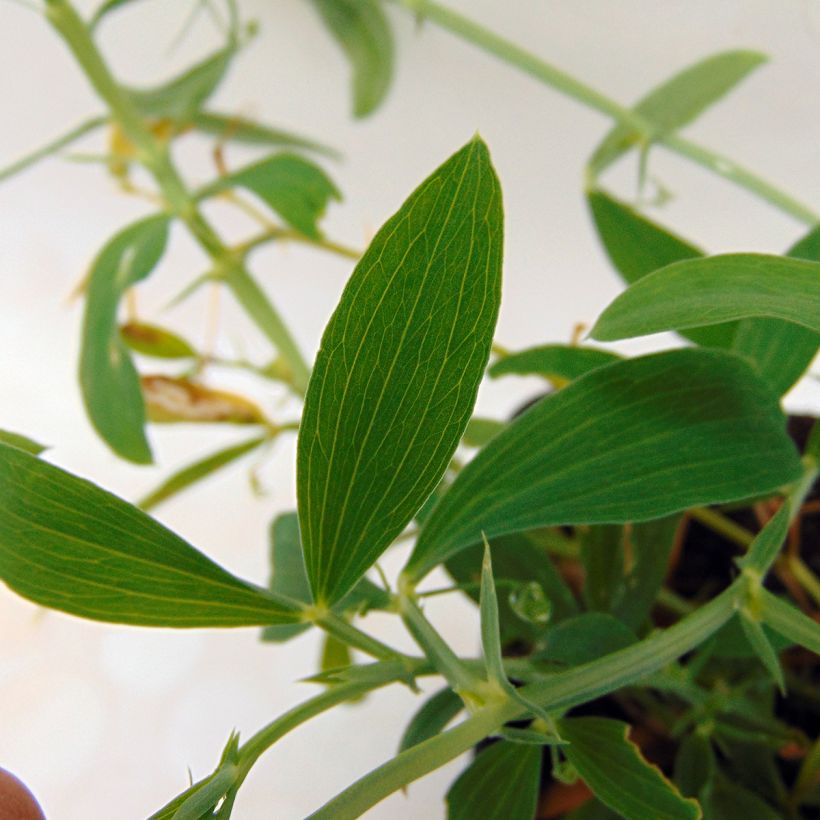

Flowering
Foliage
Plant habit
Botanical data
Lathyrus
latifolius
White Pearl
Fabaceae
Broadleaf Sweetpea, Broad-leaved everlasting-pea, Perennial Pea
South America
Other Lathyrus
Planting and care
Plant Lathyrus latifolius in full sun or partial shade. Plant it in ordinary, preferably calcareous and well-drained soil, but it can live in any good garden soil. Regular moderate watering will accelerate its growth. A sunny location, a fertiliser for flowering plants and the removal of faded flowers will promote abundant flowering from June to September and limit seed formation. Beware of snails and slugs that love to devour young plants.
Planting period
Intended location
Care
-
, onOrder confirmed
Reply from on Promesse de fleurs
Haven't found what you were looking for?
Hardiness is the lowest winter temperature a plant can endure without suffering serious damage or even dying. However, hardiness is affected by location (a sheltered area, such as a patio), protection (winter cover) and soil type (hardiness is improved by well-drained soil).

Photo Sharing Terms & Conditions
In order to encourage gardeners to interact and share their experiences, Promesse de fleurs offers various media enabling content to be uploaded onto its Site - in particular via the ‘Photo sharing’ module.
The User agrees to refrain from:
- Posting any content that is illegal, prejudicial, insulting, racist, inciteful to hatred, revisionist, contrary to public decency, that infringes on privacy or on the privacy rights of third parties, in particular the publicity rights of persons and goods, intellectual property rights, or the right to privacy.
- Submitting content on behalf of a third party;
- Impersonate the identity of a third party and/or publish any personal information about a third party;
In general, the User undertakes to refrain from any unethical behaviour.
All Content (in particular text, comments, files, images, photos, videos, creative works, etc.), which may be subject to property or intellectual property rights, image or other private rights, shall remain the property of the User, subject to the limited rights granted by the terms of the licence granted by Promesse de fleurs as stated below. Users are at liberty to publish or not to publish such Content on the Site, notably via the ‘Photo Sharing’ facility, and accept that this Content shall be made public and freely accessible, notably on the Internet.
Users further acknowledge, undertake to have ,and guarantee that they hold all necessary rights and permissions to publish such material on the Site, in particular with regard to the legislation in force pertaining to any privacy, property, intellectual property, image, or contractual rights, or rights of any other nature. By publishing such Content on the Site, Users acknowledge accepting full liability as publishers of the Content within the meaning of the law, and grant Promesse de fleurs, free of charge, an inclusive, worldwide licence for the said Content for the entire duration of its publication, including all reproduction, representation, up/downloading, displaying, performing, transmission, and storage rights.
Users also grant permission for their name to be linked to the Content and accept that this link may not always be made available.
By engaging in posting material, Users consent to their Content becoming automatically accessible on the Internet, in particular on other sites and/or blogs and/or web pages of the Promesse de fleurs site, including in particular social pages and the Promesse de fleurs catalogue.
Users may secure the removal of entrusted content free of charge by issuing a simple request via our contact form.
The flowering period indicated on our website applies to countries and regions located in USDA zone 8 (France, the United Kingdom, Ireland, the Netherlands, etc.)
It will vary according to where you live:
- In zones 9 to 10 (Italy, Spain, Greece, etc.), flowering will occur about 2 to 4 weeks earlier.
- In zones 6 to 7 (Germany, Poland, Slovenia, and lower mountainous regions), flowering will be delayed by 2 to 3 weeks.
- In zone 5 (Central Europe, Scandinavia), blooming will be delayed by 3 to 5 weeks.
In temperate climates, pruning of spring-flowering shrubs (forsythia, spireas, etc.) should be done just after flowering.
Pruning of summer-flowering shrubs (Indian Lilac, Perovskia, etc.) can be done in winter or spring.
In cold regions as well as with frost-sensitive plants, avoid pruning too early when severe frosts may still occur.
The planting period indicated on our website applies to countries and regions located in USDA zone 8 (France, United Kingdom, Ireland, Netherlands).
It will vary according to where you live:
- In Mediterranean zones (Marseille, Madrid, Milan, etc.), autumn and winter are the best planting periods.
- In continental zones (Strasbourg, Munich, Vienna, etc.), delay planting by 2 to 3 weeks in spring and bring it forward by 2 to 4 weeks in autumn.
- In mountainous regions (the Alps, Pyrenees, Carpathians, etc.), it is best to plant in late spring (May-June) or late summer (August-September).
The harvesting period indicated on our website applies to countries and regions in USDA zone 8 (France, England, Ireland, the Netherlands).
In colder areas (Scandinavia, Poland, Austria...) fruit and vegetable harvests are likely to be delayed by 3-4 weeks.
In warmer areas (Italy, Spain, Greece, etc.), harvesting will probably take place earlier, depending on weather conditions.
The sowing periods indicated on our website apply to countries and regions within USDA Zone 8 (France, UK, Ireland, Netherlands).
In colder areas (Scandinavia, Poland, Austria...), delay any outdoor sowing by 3-4 weeks, or sow under glass.
In warmer climes (Italy, Spain, Greece, etc.), bring outdoor sowing forward by a few weeks.

































